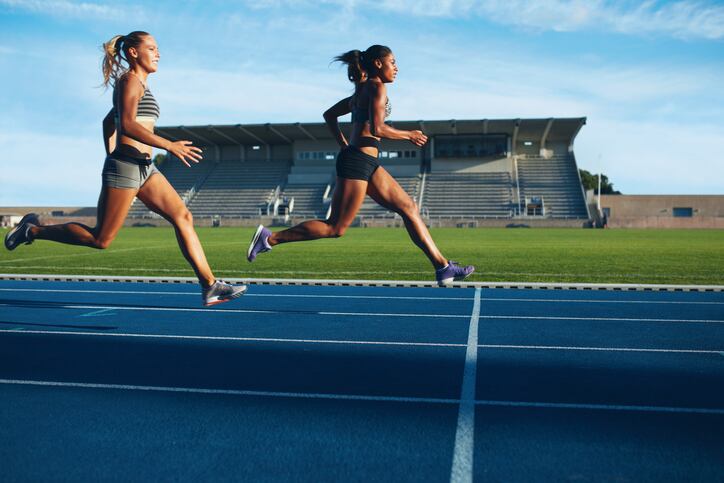This was a key take home message from Sharon Madigan, Head of Performance Nutrition at Sport Ireland Institute (SII), who gave a presentation entitled 'Bridging the sex gap in sports nutrition research' during a Nutrition Society conference in Ireland last week.
She kicked off by pointing out that women first entered the Olympic Games in 1900 and achieved parity in numbers with men in the 2021 Tokyo games, showing that equality in the sports is progressing, yet she said equality in the research is still far behind.
Madigan gave the example of carbohydrate consumption research.
“Carbs are a key factor in terms of performance in prolonged exercises…
“Recommendations, around timing and amounts, are the most frequently observed throughout history. But it’s important to realise the populations from which they have been derived.”
She noted that not only can sex impact muscle fibre composition and important hormonal factors, it also will influence substrate utilisation at different times in the menstrual cycle, and further complications come from studying women at different times in their lives – pre and post menopause.
“You can see why they have been excluded from the sports science literature in the past,” she admitted.
Looking at the differences in needs of females and males in terms of carbohydrate requirements, she pointed out that gluconeogenesis is much higher in the follicular (first) phase of the menstrual cycle than it is in the luteal (later, post ovulation) phase (Campbell et al 2021).
“Theoretically a performance detriment could occur within the luteal phase as we may then have impaired metabolism of carbohydrates."
Discussing previously suggested recommendation implications for female athletes, Madigan said a carbohydrate snack in the lead into exercise could help mitigate this metabolism issue, as well a higher levels of carb consumption during prolonged exercise.
“However, 70% of those presenting with IBS are women, so it’s not as simple as recommending higher amounts of carbs - these could have a detrimental impact on the gut. We have to look at how these recommendations can be employed in the real-world setting.
“But again, most recommendations are based on males, so is it appropriate to apply these to women?”
Want to learn more about nutrition for the female athlete?
NutraIngredients Europe will host its newly branded Active Nutrition Summit in Amsterdam from October 9-11.
An evolution of the brand's prominent annual Sports & Active Nutrition Summit, this year’s event will provide delegates with insights into the increasingly holistic and mass market view of sports nutrition, from some of the leading names in the industry.
Content pillars will cover all the hottest topics in the industry today, including: women’s health, cognitive health, life-stages nutrition, and personalisation.
Discounted Early Bird tickets are available until the end of June 2023.
She discussed research analysing the literature into fuelling the athletes with carbohydrates. One review (Kuikman et al 2022) found over 900 studies but these only included 11% female participants, compared to 89% male, and 740 studies were exclusively on male participants.
“You can see there are massive gaps, even at that basic level of carbohydrate requirements for female athletes.”
Ergogenic supplements
She pointed out there is a plethora of products aiming to provide different performance improvements and, again, most studies into these products have been carried out in male athletes.
“Due to the widely proven physiological and hormonal differences between men and women, this could lead to differences in absorption, distribution and metabolism of these substances.”
One widely used supplement for faster recovery, by both male and female athletes, is creatine.
However, there are just three articles where the study looks into anaerobic performance in female athletes and these found no clear evidence of impact on performance in this audience. So there’s a clear gap in the research in this space.
She said if research doesn’t provide the information, female athletes will find the information from elsewhere, and this is a danger to their health.
“If scientists don’t fill the gap, those on the band wagon will. There’s tonnes of information out there impacting female athletes and it’s impacting their mental health.
“Some have questions around whether they should train at certain times in their cycle, and coaches don’t know either.”
She suggested putting in place a protocol in research to include females and look at menstrual cycle status.
Body image issues
Female exercise and nutrition can be impacted by gender norms, with many looking to restrict calories to reduce their size to meet societal expectations of femininity.
“Female athletes are often employed for the marketing of merchandise and sports nutrition products. For example, Anna Kournikova has never won a grand slam but is in the top six earning athletes due to her sponsorship deals. So we can see the impact that marketing deals could have on female athletes' desire to maintain a certain body image.”
Relative energy deficiency in sports (RED-S)
Discussing the prolific issue of RED-S, Madigan noted that around 80% of the referrals to SII from doctors and physios are due to RED-S, so it’s the main reason athletes are becoming ill or injured in sports.
Dr Danielle Logue, performance nutritionist at SII, conducted research into around 1,000 females, which discovered RED-S is an issue in about 40% of them.
RED-S can lead to: recurrent and niggling injuries, recurring illness, lower performance, and fluctuating mood. So it has a huge impact on training and performance.
Madigan said these are clear motivators for athletes with RED-S to change their nutrition: “Athletes want to perform, they do not want to get sick, and they do not want to get injured, so there is your carrot.”
Discussing other areas of research which need further attention, Madigan noted gut health, bone health, sleep quality, and concussion recovery. These are all areas where women can struggle more than men.


